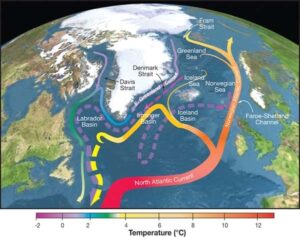Seas will rise on New England. More vicious winter storms track toward Britain & Northern Europe. Dr. Levke Caesar lead author of new paper warning the world. Meanwhile international agreements to save us STILL rely on fantasy technology. From the Potsdam Institute for Climate Impact Research, scientist Fabian Stenzel says the dream of plantations burning wood for energy would take away life-giving water from billions more humans.
Listen to or download this Radio Ecoshock show in CD Quality (57 MB) or Lo-Fi (14 MB)
OCEAN CURRENTS WARMING E. NORTH AMERICA, THE UK AND EUROPE ARE WEAKENING – LEVKE CAESAR
Ocean currents that keep the East Coast and Northern Europe warm are weakening. Proof keeps piling up. Is there a tipping point and how long until we get there? From Maynooth Ireland, Dr. Levke Caesar returns with the latest results.
In 2018, Levke published her first paper, in the journal Nature. She appeared on Radio Ecoshock to explain it. Levke Caesar is part of the Irish Climate Analysis and Research Unit at Maynooth University. She is also a guest scientist at PIK, the Potsdam Institute for Climate Impact Research, working with her co-author well-known climate scientist Stefan Rahmstorf, a co-author on this new paper. Levke Caesar was trained in German universities but now works out of Ireland as well. Ireland, where palm trees grow on the southern part of the island, could experience big weather changes as the great Atlantic circulation system continues to weaken, or even eventually stop.


Dr. Levke Caesar, Maynooth University and PIK
The latest word doesn’t sound good. Published February 2021 in Nature, the paper is called “Current Atlantic Meridional Overturning Circulation weakest in last millennium.” I’ve been waiting a couple of weeks to talk with Levke, while she was out testing more ocean currents on a research ship. She’s back and here we are.
So what is “AMOC” – the Atlantic Meridional Ocean Circulation? Outside oceanography, people want to picture a single current that is carrying less water, or changing direction. People in North America think of the Gulf Stream, but others in the UK talk about the North Atlantic Drift. Levke explains this is not one current but a great ocean engine. It is a SYSTEM with many moving parts.

AMOC
Going bigger, AMOC is the north end of a massive conveyor belt of water that stretches from Pole to Pole. The ocean transports water heated by the sun in the tropics toward both Poles (where it speeds melting of sea ice and glaciers reaching the sea). What makes the waters move? I thought maybe wind (which does steer it East) or the spin of the planet. But Chinese Oceanographer Yuping Guan told me there are two primary drivers behind ocean currents: heat differences and salt. Saltier water is heavier and tends to sink, while fresher water forms as layers in the upper ocean. The Yuping Guan interview is coming up soon.
WHERE IS THE TIPPING POINT IN THE NORTH ATLANTIC?
In the North Atlantic, salty water sinks drawing more warm waters from the Gulf Stream. But now waves of freshwater pouring off Greenland are weakening that system. Scientists have measured slowing in the AMOC system since the 1950’s. Now the slowing is becoming critical. No one is sure if there is a tipping point where this ocean exchange system will stop working, drawing Northern Europe into much colder and stormier weather – even as the rest of the world warms!
Levke tells us that is not the right way to think about what “tipping points” are. In the case of AMOC, scientists are looking for the ocean state where slowing of North Atlantic currents cannot be stopped, and will only continue to weaken. THAT is the tipping point, rather than one day it stops (as pictured in the Sci-Fi movie “The Day After Tomorrow”. While some of the long-term impacts of AMOC stopping in that film might be accurate, the whole process will take hundreds if not thousands of years – not a day or a week. However, we don’t know the time-table. Scientists suspect that the faster we warm the planet, the sooner we may approach that tipping point. In fact our Radio Ecoshock guest Johannes Lohmann discovered the RATE of change can bring tipping points sooner than simple calculations would suggest. He uses the weakening of AMOC as his case study. Find that in my Radio Ecoshock show posted March 17, 2021.
I have seen various projections of when a major tipping point might be reached. One suggests we have at least 1,000 years as a relatively safe buffer during a slow weakening. Another says that temporary shutdown could come within 100 years. For example, in her article in the Guardian (link below) Kate Ravilious concludes:
“By investigating the impact of Greenland meltwater and rainfall on AMOC, researchers found that thankfully there is very little chance of a complete shutdown in the next 1,000 years, but instead they show there is a 15% chance of a temporary shutdown in the next 100 years, which would likely trigger cooler conditions in north-west Europe.”
THREE SOURCES OF NEW FRESH WATER TO THE ATLANTIC
We also learn from Levke fresh water is increasing in the North Atlantic from three sources:
1. glacier melt in Greenland
2. less salty sea water from melting sea ice (sea ice is salty, but less than the ocean below)
3. increasing rainfall over the North Atlantic, because more water is held in a warmer atmosphere (another large climate driver)
WILL EUROPE SEE ANOTHER LITTLE ICE AGE?
The new study by Levke Caesar et al study reconstructs the North Atlantic current system all the way back to the year 400 of our Common Era. Amazing techniques from multiple modes of science were used to do that. Listen and learn. The result is we can say the North Atlantic overturning circulation has not been weaker in the last 1600 years. We can prove the big change is happening. Scientists found AMOC was relatively stable until the beginning of the industrial age. So we also know that human-induced climate change is endangering ocean systems that partly determine our weather.
I ask Levke whether Europe might really go into a “Little Ice Age” while the rest of the world sizzles. My understanding of her answer is that yes major cooling and weather disruption can happen, is already happening – but eventually global warming will overwhelm the cooling caused by current changes, and Europe would begin to heat again.
THE PREDICTION FOR 2100
“If we continue to drive global warming, the Gulf Stream System will weaken further – by 34 to 45 percent by 2100 according to the latest generation of climate models… This could bring us dangerously close to the tipping point at which the flow becomes unstable.”
– Stefan Rahmstorf, co-author from the Potsdam Institute press release
EVEN HIGHER SEA LEVEL RISE FOR THE U.S. AND CANADIAN EAST COAST!
The consequences of the AMOC slowdown could be manifold for people living on both sides of the Atlantic as Levke Caesar explains in this Potsdam Institute Press Release: “The northward surface flow of the AMOC leads to a deflection of water masses to the right, away from the US east coast. This is due to Earth’s rotation that diverts moving objects such as currents to the right in the northern hemisphere and to the left in the southern hemisphere. As the current slows down, this effect weakens and more water can pile up at the US east coast, leading to an enhanced sea level rise.”
Previous guests told us places like New England will get more sea level rise – in part because the land there is slowly sinking. It sinks after being pushed artificially high by mile-think glacier ice next door. Now that weight is gone, the slow plastic skin of the Earth is leveling, which means the coast will sink. Now we add more sea water piling up because the Gulf Stream isn’t pushing it away toward the central Atlantic. Toss in a meter or more of rising seas due to expansion of a warmer ocean and melting ice at the Poles – and it looks like New England ports like Boston and New York will go partly underwater sooner than other parts of the world.
At this time, there is no central agency or institution tasked with monitoring the health of North Atlantic currents, even though they are crucial to Western civilization as we know it. There should be. It seems this weakening current is an existential threat but developing much slower than human attention. Levke, the Potsdam team, and other scientists could come out every few years and remind us it is supremely consequential if that system breaks down. But it feels like politics will put off crucial action until it happens, which is disastrously too late.
Although this new paper from Caesar is behind a paywall, I found the full text here (provided by Springer Nature Sharedit). Who knows how long that will work.
======================================
MEDIA COVERAGE AND SOURCES ON AMOC WEAKENING
PREVIOUS ARTICLE BY LEVKE CAESAR on AMOC IN NATURE 2018
This was her first published paper – in Nature no less! Article Published: 11 April 2018
Observed fingerprint of a weakening Atlantic Ocean overturning circulation
L. Caesar, S. Rahmstorf, A. Robinson, G. Feulner & V. Saba
PREVIOUS LEVKE CAESAR RADIO ECOSHOCK INTERVIEW ABOUT THE 2018 STUDY is here.
Listen to or download this 28 minute interview with Levke Caesar in 2018 in CD Quality or Lo-Fi
—————————————
Washington Post
By Chris Mooney and Andrew Freedman, Feb. 25, 2021
———————————————-
Climate Change is Weakening the Ocean Currents That Shape Weather on Both Sides of the Atlantic
By Bob Berwyn February 25, 2021
——————————–
Weakening North Atlantic Drift could bring colder UK winters
In an ironic twist, global warming could lead to chillier conditions in north-west Europe in coming years by Kate Ravilious, January 8, 2020
————————————–
SEE ALSO THIS 2019 PAPER
Article Open Access Published: 20 March 2019
Deep-water circulation changes lead North Atlantic climate during deglaciation
Francesco Muschitiello et al in Nature Communications. By the way, “deglaciation” is where we are now!
In my non-scientists reading, this paper determined that about four hundred years after changes in the North Atlantic Deep Water (NADW) formation – abrupt climate changes appeared in Greenland ice cores. There may be a 400 year delay before impacts of deep water changes are seen. I want to know more about the ocean as a forerunner of changes on land. Are there lag times in the system we should know about?
=========================================================================================
THE MYTH BEHIND THE GLOBAL PLAN TO LIMIT WARMING
KEVIN ANDERSON AND FABIAN STENZEL
Kevin Anderson from the Tyndall Centre tore away the curtain from that BECCS tech on Radio Ecoshock five years ago. Now we have proof.
There is no real workable plan to stop extreme climate change, just a global lie at the top.
Now you know, and as GI Joe always says, “knowing is half the battle”.
The International Panel on Climate Change serves over 190 national governments. It has a plan to keep global warming below at least two degrees C warming this century. But instead of changing our fossil-based civilization, the whole plan relies on a fantasy on industrial scale planting, burning and storage of carbon. It’s called BECCS, and without that, this planet is rushing toward a climate shift so extreme some scientists call it extinction level. In 2016, I interviewed the outspoken Deputy Director of one of the world’s top climate research agencies, the Tyndall Centre in the UK. We start with Dr. Kevin Anderson’s brief introduction to the problem on Radio Ecoshock, followed by my new interview with lead author of key research on proposed carbon-slashing technology, with Fabian Stenzel in Potsdam Germany.
I play a couple of minutes from Radio Ecoshock, November 16, 2016 with Kevin Anderson. Now let’s get to the proof with our new guest from Germany.
FABIAN STENZEL: ONE “GREEN” CLIMATE FIX MAY BE WORSE THAN CLIMATE CHANGE ITSELF…
Let’s just green the planet! We will reforest Earth to capture carbon dioxide that threatens the future. Official institutions are counting on that bio-capture and storage. But like so many big human ideas, this climate solution could make things worse. Our guest Fabian Stenzel is a PhD Student in Germany. He works with the Potsdam Institute for Climate Impact Research. His new analysis is published in the journal Nature on March 8 2021.

Fabian Stenzel, Potsdam Institute Germany
The paper is “Irrigation of biomass plantations may globally increase water stress more than climate change.” It is Open Access, you can read it for free, as published 08 March 2021 in the top journal Nature.
We had Swiss scientist Thomas Crowther on Radio Ecoshock. He calls for planting billions more trees. Is that enough or does this attempt at “natural” global cooling need plantations? It could only help, but Stenzel puts the whole scheme of bio-capture to the test. Because the hydrological cycle is altered by climate change (rain, snow), and the best soils with enough rainwater are already under cultivation to feed billions of humans – irrigation would be needed to get meaningful amounts of carbon out of the air with plants.
But over two billion people already suffer terrible water stress right now. They can’t get enough for their crops, their personal needs, or industry. If we tried big plantations to get the carbon capture the IPCC and Climate Accords are counting on – even more billions of humans would run out of water, Stenzel finds. Oh by the way, existing plants and animals would be robbed of their water and room to grow too.
There is a world water scarcity clock. It counts the number of people facing water stress. When I checked, it was heading above 2 billion, 400 million. That is almost one in three people on the planet always looking for enough water to bathe, clean up, or even to drink safely.
BECCS BIO-ENERGY WITH CARBON CAPTURE AND STORAGE
So the grand plan advanced by this civilization as a fix for climate change involves:
1. massive planting of plants (could be trees, shrubs, anything that captures lots of carbon from the atmosphere)
2. harvesting that “bio-mass” and burning it to produce energy
3. capturing the carbon dioxide released at those power stations and pushing it into some sort of storage (for thousands of years)(which means creating another whole infrastructure of pipelines, carbon wells, and lots of emissions)
Then we toss in a final fact that destabilizes even those plans: human population continues to grow, adding billions more people, and billions more consumers. To his credit, Fabian Stenzel doesn’t pretend that is not happening, but instead factors population growth into his model as well. Needless to say, it makes BECCS even more unlikely to work in any way big enough to matter (says Alex). During the interview, Fabian says they inherit their socio-economic model from the INTIMATE network of modellers.
Stenzel says bio-capture and storage as a climate carbon cure is worse than the disease. He finds “the global area and population living under severe water stress in the BECCS scenario would double compared to today” .
———————————–
MORE FROM KEVIN ANDERSON – THE NEGATIVE EMISSIONS SCAM
We wrap up with more from my 2016 interview with Kevin Anderson then of the Tyndall Centre. He explains the madness of counting on fantasy to bail us out of a horrible climate shift. The main message of my talk with Kevin is the way governments and the IPCC simply ASSUME that humans will capture and store vast amounts of carbon, in order to relieve the overloaded atmosphere. Look at the future pathways in the IPCC reports, says Anderson, and you will find very large assumptions that carbon capture and storage will happen. We don’t have a workable technology to do it yet. So that’s a big gamble.
Even worse, warns Anderson, these projections allow world leaders, even through the Paris climate accord, to put off painful (and unpopular?) carbon cuts now. The say we will put all that tough climate action off to 2030 or beyond. That means we are not cutting emissions nearly enough now.
Kevin describes various technologies, and hints at their side-effects. It’s like strong pharmaceuticals, the side-effects can be as serious as the disease. There is a good article about all this at Climate Central here.
Or watch this video of Kevin Anderson on negative emissions on You tube, posted Oct 13, 2016 by Carbon Brief.
Download or listen to this full 2016 Radio Ecoshock interview with Kevin Anderson in CD Quality or Lo-Fi. It is just as important today in 2021.
As always, you can listen to all our past Radio Ecoshock interviews free, thanks to the generosity and support of listeners who donate or become subscribers to this program. If you can afford to help, find out how to help here. Teach yourself about what is happening to our world. Download the latest science, direct from the scientists, for your IPOD, mp3 player or computer. You can listen later, or pass the link on to everyone. Please consider becoming a climate influencer using Radio Ecoshock.
Join us again next week as we continue our trek toward ecological sanity. I’m Alex Smith. Thank you for listening, and caring about our world.
Another great show. hope your audience is growing with the fb presence. I will be doubling my monthly check-off shortly.
Unfortunately Stenzel only got to the water cycle potential for mitigation at the very end. I sent the show URL to Walter Jehne in AU, I hope you can interview him on the very likely short term benefits of green vegetation inducing rainfall etc.
Pingback: News this week: the push to call nuclear ”green” | Nuclear Australia
Pingback: Freezing Europe More Likely Despite Global Heating – RADIO ECOSHOCK - Civipress News